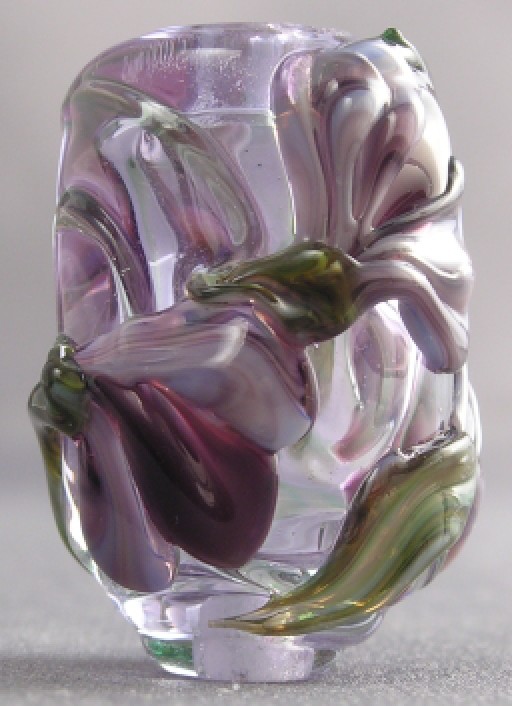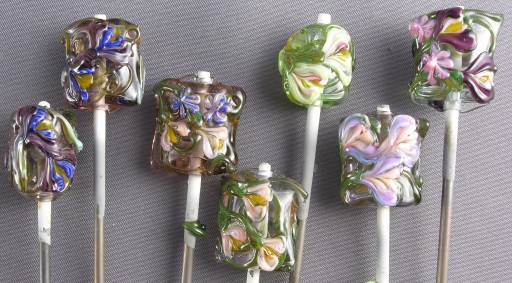To my mind the thing that distinguishes commonplace florals from really outstanding florals is the quality of the trailing: that is, how nicely shaped the petals (and stems) are. There are two competing parameters for this type of decoration: on the one hand, it needs to be melted in sufficiently to avoid cold seals (undercuts); on the other (at least in my opinion) leaves, stems and most especially petals need to be crisp with good definition, in order to evoke the delicacy of living flowers.
I've been making florals for many years, and they're one of my favorites. And I think I have the other essential—good, interesting colors—down reasonably well: it helps that I enjoy experimenting with new combinations for floral canes, and certainly my background in color theory has proven very helpful in avoiding the bright kelly green with black striping trap for greenery!
But my petals, compared to, say, Leah Fairbanks or Kim Fields, or especially Kristen Frantzen Orr, often struck me as mushy, inconsistant and poorly shaped. The obvious fix to this problem is practice, so I decided to make a bunch of designer sized beads with florals. I figured by the time I did 500 or so, they'd start to get decent. To make my life easier, I reverted to 3/32” mandrels (typically I use 1/16"). I did continue to use high-graphite content release, though the zippy stuff tended to crack. [1]
To give myself more real estate while still keeping the bead (nominally) bracelet size, I switched from round to cylinder shape, which I figured would be good practice besides. I do try to make flowers pointing both down and up.
The top bead is the first that I felt was really successful.
The bottom batch is the latest. In the meantime, I've experimented with Bullseye versions (very frustrating, because much of the palette isn't sufficiently opaque to make good floral canes) and other flower types (e.g. goldenrod) besides the basic crocus form shown here. —I even took a brief detour into boro ornaments, which crashed and burned (heh) with the latest efforts to do anything more complicated than a simple blown ornament.
So it was with considerable relief that I returned to this series after taking about a week off. I'm around 300 so far, and have added playing with presses to the repetoire of exercises. I'm particularly happy with some of the colors—only problem is, I made the canes so long ago I've forgotten the recipes, which means having to recreate them, a sometimes frustrating exercise.[2]
But even the green and pink floral, which I really like, and is mostly made with canes I made today...um, lesse, I think I started with opaque pink, and striped on some pea green opaque, and obviously some cranberry...or was it white on the pink and then cased with a big swap of that darker special version of transparent grass green...? And wasn't there a version that had EDP under the cranberry, er gold ruby, this being effetre, not bullseye...Bother. (But perhaps you begin to see why I have problems documenting my canes.)
The yellow centers on the two left beads are ancient yellow and black murrina cane from doing GLBG's commemorative beads, and they were too dull, so I made a second cane, with medium cadmium yellow encased with a medium amber and striped with opaque white. Pure yellow would've been too intense; the transparent amber toned down the brilliant opaque yellow, and the white gives some subtle variation.
And obviously I have a ways to go with the daisy shape (sigh). So, why are my crocus petals nice, and my asterae (that the family that many daisy-shaped flowers are in) are so poor? As with nearly everything in glass, it's all about heat control. I discovered the way to get textural petals, as opposed to the standard half-round in cross section petals that most people do, involved controlling the heat zones very precisely.
Firstly, the base bead has to be fairly cool (no suprise there, or your petal melts in). This is why I'm making these practice beads small—I don't have to worry about the other end of the bead cracking while I futz around making a flower at this one. It's also why the flowers can be multicolored—I have to let the central petal cool before I can add side petals, so it really doesn't slow me down that much to switch between each batch of colors, since I make each layer of petals, going round and round, rather than starting and completing a (crocus) flower.
Secondly, whilest the very tip of the stringer has to be nearly drippy, the remainder immediately behind needs to be stiff, because it is a self-tool that pushes the molten glass before it. You can see this particularly in the right top edge of the top photo. Initially, I didn't have ratio molten to stiff lengths on the stringers quite right, and I snapped a lot of them, pushing too hard on not enough of the drippy stuff. (The converse, having too much softened glass, results in mushy petals.) The hand movements must be quick, before the glass stiffens back up: endless practice to make the move second nature is critical for success. So yes, the sharp little flame of my lynx is nice for floral trailing.
If there is a long gradient of heat, that is, a sorta-sloppy softened part of the stringer above the very tip, then the trailing will be globby. As it is my daisies. Admittedly, if I used 2mm stringer (as I do for the crocus), as opposed to the often <1mm stringers, it would probably be a little easier (but then they would be too big for fillers)...well, I have another 200 beads to get this down.
photos, post, begun 7oct08; post completed, intro added 8oct.
[1]Somewhat counterintuitively, you thin when this happens. Happy to thin and thin—until the release starts sliding right off the mandrel. I mixed it half and half with the rest of my krag mud, and now it's fine.
[2]Because I tend to just keep slopping colors on my canes till I think I have something fun, it can be difficult to document them—especially as I often have no idea something's good till hours or days later, when I pull the annealed bead out of the kiln. For example, the two coral-tint flowers in the middle came from a cane that appeared white—evidently, I used tongue pink or something like that for the core, and it went white when pulled out.
Unless otherwise noted, text, image and objects depicted therein copyright 1996--present sylvus tarn.
Sylvus Tarn
